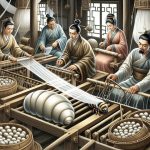Do you want to know what luxe silk fabric is? Well, you’re in the right place!
In this article, we’ll explore the origins, properties, and manufacturing process of this luxurious fabric.
We’ll also provide tips on how to care for and style it to perfection.
So, get ready to dive into the world of luxe silk fabric and discover why it’s the epitome of elegance and sophistication.
Table of Contents
The Origins of Luxe Silk Fabric
The origins of luxe silk fabric can be traced back to ancient China. Silk fabric production has a rich and fascinating history that dates back thousands of years. The Chinese were the first to discover the silk moth and its cocoon, which led to the development of silk fabric. The process of silk production involves carefully unraveling the silk threads from the cocoon and weaving them into luxurious fabric. This intricate process requires skilled craftsmanship and attention to detail.
Silk fabric has played a significant role in Chinese culture and trade. The Chinese kept the production of silk a closely guarded secret for centuries, making it a highly valuable and sought-after commodity. Silk became a symbol of wealth and luxury, coveted by emperors, nobility, and traders alike.
Over time, the knowledge of silk production spread to other parts of the world, leading to the establishment of silk industries in countries like India, Persia, and later Europe. Today, silk fabric continues to be synonymous with elegance and opulence, adorning runways and high-end fashion houses around the globe.
The origins of luxe silk fabric in ancient China set the stage for its enduring legacy as a symbol of beauty and refinement. Its history is a testament to the skill, ingenuity, and cultural significance of silk fabric production.
Properties and Characteristics of Luxe Silk Fabric
Feel the smoothness and lustrous shine of this luxurious material as it glides against your skin. Luxe silk fabric is known for its exceptional properties and benefits, making it a popular choice among discerning individuals. Here are some key characteristics that set luxe silk fabric apart from other fabrics:
- Breathability: Silk fabric allows air to circulate, keeping you cool and comfortable in warm weather.
- Moisture-wicking: The natural properties of silk help absorb moisture, keeping you dry and fresh throughout the day.
- Hypoallergenic: Silk is resistant to dust mites and allergens, making it an excellent choice for those with sensitive skin or allergies.
- Versatility: Silk fabric is highly versatile and can be used for a wide range of applications, from clothing to home decor.
Compared to other fabrics, luxe silk stands out for its luxurious feel and elegant appearance. It has a unique ability to drape beautifully, creating a flattering silhouette. Additionally, silk fabric is known for its durability, allowing garments made from it to withstand the test of time.
Whether you’re looking for comfort, style, or durability, luxe silk fabric is a top choice that will never disappoint.
Different Types and Grades of Luxe Silk Fabric
Experience the breathability and moisture-wicking properties of different types and grades of this luxurious material.
Luxe silk fabric comes in various types and grades, each offering unique benefits. Mulberry silk, known for its smooth texture and durability, is considered the highest quality among silk fabrics. Its long fibers make it highly breathable, allowing air to circulate and keeping you cool and comfortable throughout the night.
Charmeuse silk, with its lustrous appearance and soft feel, is another popular choice. It drapes beautifully and has a luxurious sheen that adds elegance to any garment.
Habotai silk, also known as China silk, is lightweight and perfect for delicate clothing items such as blouses and lingerie. It is smooth and has a slight sheen, making it ideal for creating flowing and feminine designs.
Luxe silk fabrics, regardless of type or grade, share common benefits. They are hypoallergenic, making them suitable for individuals with sensitive skin. Additionally, silk has natural moisture-wicking properties, which help to regulate body temperature and keep you dry.
Experience the comfort and luxury of luxe silk fabric in your everyday attire.
The Manufacturing Process of Luxe Silk Fabric
Immerse yourself in the intricate process of manufacturing this luxurious material. Silk, known for its softness and sheen, goes through several manufacturing techniques and stages before it becomes the luxurious fabric we know and love.
Cocoon Harvesting: Skilled workers carefully collect silk cocoons from silkworms, gently unraveling the delicate threads.
Filament Extraction: The silk filaments are then carefully extracted from the cocoons by boiling them in water, which softens the sericin, a natural gum that holds the filaments together.
Spinning: The extracted filaments are spun together to form threads, which are then twisted into silk yarns. This process requires precision and skill to ensure the yarns are strong and uniform.
Weaving: The silk yarns are woven into fabric using various techniques, such as plain weave or satin weave. This step determines the texture and drape of the final fabric.
Throughout these silk production stages, manufacturers pay close attention to quality control to ensure the fabric meets the highest standards. From harvesting the cocoons to weaving the threads, every step is vital in creating the luxurious and sought-after silk fabric that is cherished worldwide.
Care and Maintenance of Luxe Silk Fabric
When it comes to caring for your luxe silk fabric, there are a few key points to keep in mind.
First, it’s important to know how to wash silk properly to avoid damage.
Additionally, storing silk garments correctly is crucial to maintaining their quality and preventing wrinkles.
Lastly, knowing how to remove stains from silk can help preserve the beauty of your garments for years to come.
Washing Silk Properly
To maintain the quality of your luxe silk fabric, it’s important to follow the proper washing instructions. Here are some silk care tips and the benefits of washing silk properly:
-
Gentle Hand Washing: Gently wash your silk fabric in cool water with a mild detergent to prevent damage.
-
Avoid Agitation: Do not wring or twist the fabric while washing to prevent wrinkles and stretching.
-
Air Dry: Lay the silk fabric flat on a clean towel and allow it to air dry. Avoid direct sunlight as it can fade the color.
-
Iron with Care: Use a low-temperature setting on your iron or steam the silk fabric to remove wrinkles. Iron on the reverse side to prevent shine marks.
Storing Silk Garments
To properly store your silk garments, make sure to clean them thoroughly before placing them in a cool, dry area away from direct sunlight.
Silk is a delicate fabric that requires special care to maintain its beauty and prevent wrinkles.
When storing silk, it is important to avoid hanging it, as this can cause it to stretch and lose its shape. Instead, fold the garments gently and place them in a breathable storage bag or box.
Avoid using plastic bags, as they can trap moisture and promote mold growth. Additionally, avoid storing silk garments near items with strong odors, as silk can absorb smells easily.
Removing Stains From Silk
Removing stains from silk can be a tricky process, but with a gentle touch and the right stain-removal techniques, you can restore your silk garments to their original beauty.
Here are some common silk stain removal techniques to help you tackle those pesky stains:
-
Blotting: Gently blot the stain with a clean, white cloth to absorb any excess liquid.
-
Cold water: Rinse the stained area with cold water to dilute the stain and prevent it from setting.
-
Mild soap: Use a mild soap or delicate fabric detergent to gently rub the stain in a circular motion.
-
White vinegar: Mix one part white vinegar with three parts water and dab the stain with a clean cloth.
If you prefer DIY silk stain removers, try mixing equal parts of lemon juice and water, or creating a paste with baking soda and water.
Remember to always test any stain remover on a small, inconspicuous area of the silk before applying it to the stain.
Styling and Fashion Tips for Luxe Silk Fabric
Pairing luxe silk fabric with statement accessories can elevate your style effortlessly. Silk has been a popular fabric in the fashion industry for centuries, known for its luxurious feel and elegant drape. When styling silk, it’s important to keep in mind the latest fashion trends to create a chic and fashionable look.
Here are some styling tips to help you make the most of your luxe silk pieces:
-
Color-blocking: Experiment with bold and contrasting colors to create a vibrant and eye-catching outfit. Pair a silk blouse in a bright hue with a contrasting skirt or pants for a modern and stylish look.
-
Layering: Layering silk with other fabrics can add depth and texture to your outfit. For a trendy and effortless look, layer a silk camisole under a tailored blazer or a chunky knit sweater.
-
Accessorize: Statement accessories can take your silk ensemble to the next level. Opt for bold and chunky jewelry, such as oversized earrings or a statement necklace, to add a touch of glam to your look.
-
Mix and match: Don’t be afraid to mix silk with other fabrics and textures. Pair a silk dress with a leather jacket for an edgy and chic ensemble, or mix silk pants with a cozy knit sweater for a stylish and comfortable outfit.
Conclusion
In conclusion, luxe silk fabric is a luxurious and sought-after material known for its smooth texture and elegant appearance. It has origins dating back thousands of years and has been prized for its natural sheen and breathability. There are various types and grades of luxe silk fabric available, such as charmeuse and crepe de chine, each with its own unique characteristics. The manufacturing process involves careful harvesting and processing of silk fibers. Proper care and maintenance are essential to preserve the fabric’s quality.
When styled and accessorized correctly, luxe silk fabric can elevate any outfit to a new level of sophistication.
- The History and Evolution of Chamois Fabric - June 22, 2025
- Chamois Fabric on Wikipedia: What You Need to Know - June 22, 2025
- How to Pronounce Chamois Fabric Correctly - June 22, 2025




